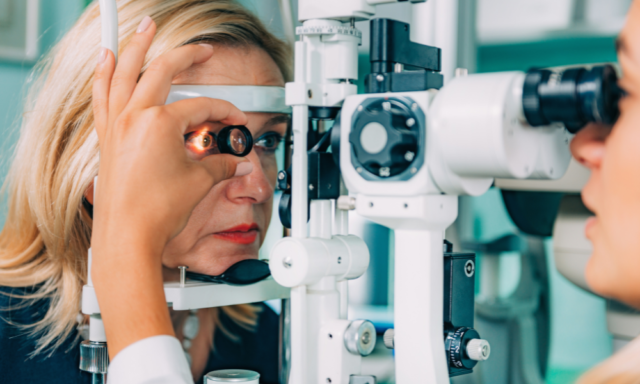Optometrists are often the first healthcare providers to detect signs of systemic diseases during routine eye exams — a lot of pathology involves the eye. Adults in the U.S. visit eye care providers more often than primary healthcare providers, which places ECPs in a crucial role for early detection and referrals, facilitating timely intervention and potentially preventing more serious health complications.
It’s important to stay abreast of the diagnostic developments in this area, of course. You can also use this unique facet of optometry to attract and retain patients. The invaluable benefit of regular eye exams on total health is not common knowledge, and you’d be well served making patients aware.
Messaging should always emphasize that regular eye exams are essential not only for maintaining good vision but also for monitoring one’s overall health. We’ve compiled a primer on the ways optometrists contribute to the early detection and subsequent management of systemic diseases, plus current related reads to help you with detection:
1. Diabetes
In the past, diabetes was identified in eye clinics only after visible signs of diabetic retinopathy. Recent research has identified subclinical and clinical changes that occur in the anterior segment of the eye with metabolic disease that allows for detection of diabetic eye disease at an early stage. Optometrists can also be on the lookout for early signs of diabetic retinopathy like microaneurysms, hemorrhages, and exudates in the retina.
Related reads:
Recognizing the Early Signs of Diabetic Eye Disease
Advancements in the Treatment of Diabetic Retinopathy: A Glimpse into Cutting-Edge Therapies
2. Hypertension
Signs of hypertensive retinopathy include narrowing of blood vessels, retinal hemorrhages, and optic disc swelling. Noticing these signs can lead to a prompt referral for an evaluation to initiate hypertension management and reduce the risk of stroke or heart attack.
Related read: Don’t Let the Pressure Get to You — or Your Patients: 3 Questions ODs Should Be Asking Themselves
3. Autoimmune Diseases
Conditions like lupus and rheumatoid arthritis can present with eye symptoms like dry eye, uveitis, or scleritis that you can identify during routine exams. The first symptoms of Myasthenia gravis often involve drooping eyelids in one or both eyes and/or double vision, and dry eyes are a key feature of Sjögren’s syndrome. While not technically categorized as an autoimmune disease, the inflammatory disease sarcoidosis causes iritis and severe light sensitivity.
Related reads:
Autoimmune Disease and the Eye
Purtscher-Like Retinopathy: A Warning Sign of Lupus
4. Thyroid Disease
Piggybacking off autoimmune disease detection, optometrists can spot thyroid eye disease, which causes symptoms like proptosis, dry eyes, and double vision. Detecting thyroid-related eye symptoms early enables referral to an endocrinologist, oculoplastic surgeon, etc. for thyroid management and prevention of more severe complications.
Related reads:
Identifying the Constellation of Signs and Symptoms in TED
Thyroid Eye Disease In Your Exam Lane
Thyroid-Associated Ophthalmopathy: The Role of Oxidative Stress
5. Multiple Sclerosis
Optic neuritis is often one of the first symptoms of MS and can be identified through symptoms like sudden vision loss or pain with eye movement. Once you’ve detected optic neuritis in an eye exam, you can refer to a neurologist for diagnosis and management.
Related reads:
Optometry’s Role in Multiple Sclerosis
Vision Problems Associated With Multiple Sclerosis
6. Cardiovascular Diseases
Changes in the retinal blood vessels, such as arteriovenous nicking or cotton wool spots, can indicate underlying cardiovascular issues. ODs can detect these signs during a dilated eye exam. Speedy referral to a cardiologist for further assessment can help prevent serious outcomes.
Related read: Ocular Manifestations of Common Cardiovascular Diseases
7. Cancer
Cancers like ocular melanoma, primary intraocular lymphoma (PIOL), or metastatic tumors, can present with eye symptoms and unusual growths or lesions in the eye. Early detection leads to referral for oncology evaluation and treatment and can potentially improve the prognosis.
Related reads:
Understanding Ocular Metastatic Tumors and Simulating Lesions
How to Manage a Patient with Ocular Metastases?
Primary Intraocular Lymphoma: StatPearls
Effect of UV Radiation on Ocular Melanoma Differs Between Parts of the Eye
8. Infectious Diseases
Infections like HIV/AIDS or tuberculosis can have ocular manifestations such as retinitis or uveitis. Syphilis, herpes, chlamydia, gonorrhea, genital warts, and pubic lice can also all affect layers of the eye. Identification can prompt crucial further testing and treatment of the underlying infection.
Related reads:
Ocular Manifestations of HIV
Ocular Manifestations and Diagnosis of Tuberculosis Involving the Uvea: A Case Series
If you want to shore up on your early detection skills even further, check out 20 Surprising Health Problems an Eye Exam Can Catch from the American Academy of Ophthalmology that includes additional conditions like giant cell arteritis, high cholesterol, sickle cell disease, and more. There’s a lot to look for during a routine eye exam, but with your help, patients can benefit from potentially life-saving early detection.





